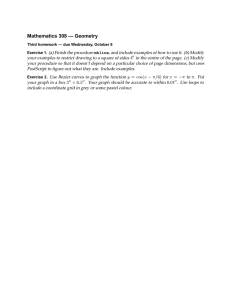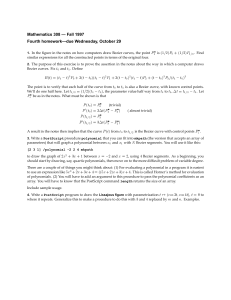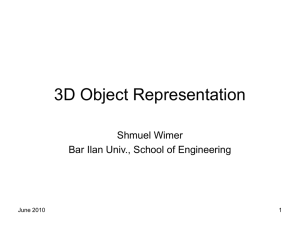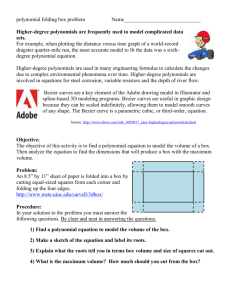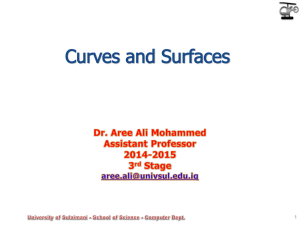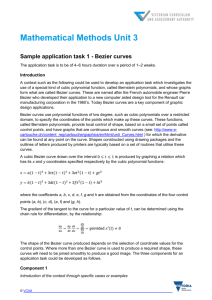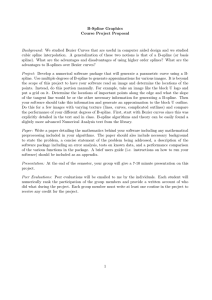MA 323 Geometric Modelling Course Notes: Day 17 Bezier Splines I
advertisement
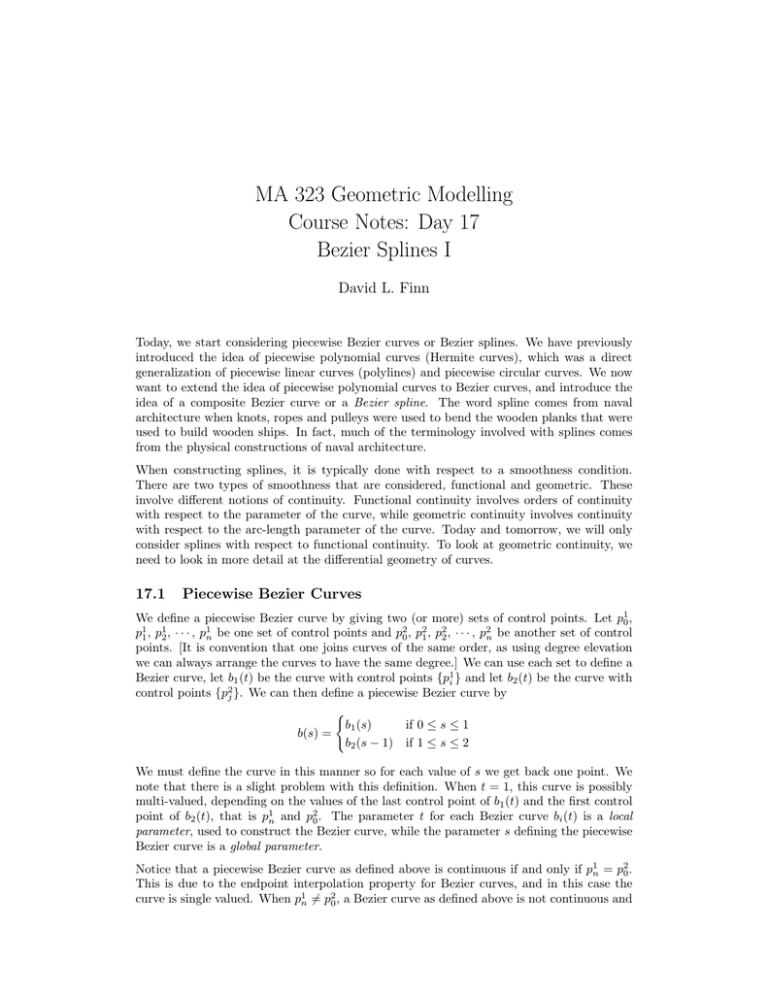
MA 323 Geometric Modelling
Course Notes: Day 17
Bezier Splines I
David L. Finn
Today, we start considering piecewise Bezier curves or Bezier splines. We have previously
introduced the idea of piecewise polynomial curves (Hermite curves), which was a direct
generalization of piecewise linear curves (polylines) and piecewise circular curves. We now
want to extend the idea of piecewise polynomial curves to Bezier curves, and introduce the
idea of a composite Bezier curve or a Bezier spline. The word spline comes from naval
architecture when knots, ropes and pulleys were used to bend the wooden planks that were
used to build wooden ships. In fact, much of the terminology involved with splines comes
from the physical constructions of naval architecture.
When constructing splines, it is typically done with respect to a smoothness condition.
There are two types of smoothness that are considered, functional and geometric. These
involve different notions of continuity. Functional continuity involves orders of continuity
with respect to the parameter of the curve, while geometric continuity involves continuity
with respect to the arc-length parameter of the curve. Today and tomorrow, we will only
consider splines with respect to functional continuity. To look at geometric continuity, we
need to look in more detail at the differential geometry of curves.
17.1
Piecewise Bezier Curves
We define a piecewise Bezier curve by giving two (or more) sets of control points. Let p10 ,
p11 , p12 , · · · , p1n be one set of control points and p20 , p21 , p22 , · · · , p2n be another set of control
points. [It is convention that one joins curves of the same order, as using degree elevation
we can always arrange the curves to have the same degree.] We can use each set to define a
Bezier curve, let b1 (t) be the curve with control points {p1i } and let b2 (t) be the curve with
control points {p2j }. We can then define a piecewise Bezier curve by
(
b1 (s)
if 0 ≤ s ≤ 1
b(s) =
b2 (s − 1) if 1 ≤ s ≤ 2
We must define the curve in this manner so for each value of s we get back one point. We
note that there is a slight problem with this definition. When t = 1, this curve is possibly
multi-valued, depending on the values of the last control point of b1 (t) and the first control
point of b2 (t), that is p1n and p20 . The parameter t for each Bezier curve bi (t) is a local
parameter, used to construct the Bezier curve, while the parameter s defining the piecewise
Bezier curve is a global parameter.
Notice that a piecewise Bezier curve as defined above is continuous if and only if pn1 = p20 .
This is due to the endpoint interpolation property for Bezier curves, and in this case the
curve is single valued. When p1n 6= p20 , a Bezier curve as defined above is not continuous and
17-2
the definition is not single-valued. A piecewise Bezier curve that is continuous (p1n = p20 ) is
said to have zeroth order continuity. Higher orders of functional continuity are defined by
continuity of the derivatives of the curve at the joint point p1n = p20 .
Figure 1: A piecewise Bezier curve consisting of 4 cubic curves
In the diagram above, notice that there is a sharp corner where the first and second arcs are
joined and there is a sharp corner where the three and fourth arcs are joined, but there is
no apparent corner where the second and third arcs are joined. Even though the individual
Bezier curves are smooth, piecewise Bezier curves do not have to be smooth. At the joint
p1n = p20 , the piecewise Bezier curve can have a sharp corner as illustrated in the diagram
above. To define a piecewise Bezier curve, so that it does not have a sharp corner, we
consider the value of the derivative for each curve at the joint pi (1) = pi + 1(0) (using the
uniform knot sequence see below), the values of the derivatives p0i (1) and p0i+1 (0). Recall
from the previous notes that the derivative of a Bezier curve
b(t) =
n
X
Bin (t) pi
i=0
is the Bezier curve
b0 (t) =
n−1
X
n Bin−1 (t) ∆i p,
i=0
where ∆i p = pi+1 − pi are the first differences of the control points. Therefore using a
uniform knot sequence that is t0 = 0, t1 = 1, t2 = 2 et cetera, we have that
b01 (1) = n (p1n − p1n−1 ) = n (p21 − p20 ) = p02 (0)
from B0n (0) = 1 and Bin (0) = 0 if i > 0, and Bin (1) = 0 if i < n and Bnn (1) = 1. We thus
conclude from p20 = p1n that p20 = p1n = 12 (p1n−1 + p21 ). Therefore, to construct a piecewise
Bezier curve using two curves we give n points for each curve, and define the joint point as
17-3
the midpoint of the the segment p1n−1 and p21 . An example of such a joining of two Bezier
curves to produce a piecewise defined Bezier curve is given below.
Figure 2: Construction of cubic C 1 Bezier spline of two segments
The procedure above generalizes to construct C 1 Bezier splines. For the remainder of this
chapter we will mainly consider piecewise cubic Bezier curves, which we will consider in
detail in the next section. But first, we note that there is no reason that we have to use
0 ≤ t ≤ 1 as the interval over which the first Bezier curve is defined and there is no
reason that we have to use 1 ≤ t ≤ 2 as the interval over which the second Bezier curve is
defined. We can instead define the composite curve over the arbitrary subintervals. This is
an important observation that will be exploited when defining B-splines and is important
in animation, at it allows one to use time explicitly in controlling the motion and designing
the path of the motion.
To define a piecewise Bezier curve, we thus technically require in addition to control points
a knot sequence t0 < t1 < t2 < · · · < tL where L is the number of arcs used to create
the piecewise Bezier curve. The knot sequence t0 = 0, t1 = 1, · · · , tL = L is called the
uniform knot sequence, and if no knot sequence is given you are to assume that the uniform
knot sequence is used in creating a piecewise Bezier curve. To create a Bezier curve using a
nonuniform knot sequence, we first consider the linear transformation that maps the interval
t0 ≤ t ≤ t1 to 0 ≤ τ ≤ 1, that is τ = (t − t0 )/(t1 − t0 ). We then use (t − t0 )/(t1 − t0 ) as the
parameter in the Bernstein polynomials defining the Bezier curve, to define the curve c1 (t)
can be defined as
¶
µ
n
X
t − t0
t − t0
p1i = b1 (
),
c1 (t) =
Bin
t
−
t
t
1
0
1 − t0
i=0
where b1 is the Bezier curve with control points {p1i }. The second arc of the piecewise Bezier
17-4
curve is likewise defined as
c2 (t) =
n
X
i=0
µ
Bin
t − t1
t2 − t1
¶
p2i = b2 (
t − t1
).
t2 − t1
This can be extended to other other arcs defined on ti ≤ t ≤ ti+1 in the obvious manner.
We note the parameterization of the curve has no affect on the zeroth order continuity of
a piecewise Bezier curve. The equality of the first and last control points determine the
zeroth order continuity. In fact, the fact that ci (t) = bi ((t − ti−1 )/(ti − ti−1 )) implies that
the parameterization of a piecewise Bezier curve has no affect on the shape of the curve,
since τ (t) = (t − ti−1 )/(ti − ti−1 ) is a one-to-one and onto function from [ti−1 , ti ] to [0, 1],
and there is a inverse t = ti−1 + τ (ti − ti−1 ). Reparameterizations of a curve in general have
no affect on the shape of curve, but can affect the smoothness of the curve as you are to
demonstrate in one of the exercises.
Exercises
1. Play with the applet: Creating C 0 Bezier Splines. This applet uses the uniform knot
sequence, as the knot sequence has no affect on the curve.
2. Where do you place the control points to approximate a circle with a C 0 Bezier spline?
Use the Applet: Fitting a C 0 Bezier spline to a circle to investigate this. How does
the number of segments change the configuration of the control points and the control
polyline?
3. Given the control polyline below sketch the C 0 cubic Bezier spline.
Figure 3: Construct C 0 cubic Bezier spline
17-5
4. Given the control points below, determine if the C 0 cubic Bezier spline will be differentiable with the uniform knot sequence.
Figure 4: Is this C 0 Bezier spline differentiable?
5. Determine the conditions required for a piecewise Bezier curve with two cubic curves
with control points pk0 , pk1 , pk2 and pk3 (k = 1 or k = 2) using the nonuniform knot
sequence t0 , t1 , t2 to be C 1 , that is have a continuous derivative
P 3 at the joint point1
0
0
(t
)
where
b
(t)
=
Bi ((t−t0 )/(t1 −t0 )) pi
(t
)
and
b
means
compute
b
p13 = p20 . This
1
2 1
1 1
P 3
and b2 (t) =
Bi ((t−t1 )/(t2 −t1 )) p2i , and determine the relations between p12 , p13 = p20 ,
p21 .
17.2
C 1 cubic Bezier Splines
We now start considering curves that truly are Bezier splines. Our principal interest in this
section is with C 1 cubic Bezier splines. Cubic Bezier splines are of special interest as they
allow us to define and approximate curves very well with simple curves. The approximation
of a circle by using cubic curves to approximate a quarter circle in the interactive exercises
is a simple example of the use of cubic Bezier splines.
Let us start by considering, a piecewise Bezier curve consisting of three cubic Bezier curves.
To define this piecewise curve, we need 10 control points. Each cubic curve requires 4 points
for a total of 12 points, but there are two joint points, meaning we need 10 control points.
If we desire the curve to smooth at the joint points, we really only need 8 control points,
as the joint points are defined by the two nearest points. The first three control points of
the first cubic curve segment, the last three control points of the third cubic curve segment,
and the middle two control points of the second curve segment, see the diagram below.
In general, we need to be given 2L + 2 points to define a C 1 cubic Bezier spline (with the
uniform knot sequence) that is made up of L cubic Bezier arcs. This is an advantage over
the number of points that must be given to create a C 0 cubic Bezier spline, as 3L + 1 points
need to be given to create a C 0 cubic Bezier spline. The exact procedure for producing the
Bezier spline is given below. We start with the spline control points d−1 , d0 , d1 , · · · , d2L .
[The index in defining the spline control points begins at −1 so that the last spline control
17-6
Figure 5: A differentiable piecewise Bezier curve of three segments
point is given by 2L from which it is easy to determine the number of curve segments.] To
produce, the L cubic Bezier curves we need 4L control points, however since the spline is
to be continuous L − 1 of these points are joints (the points where consecutive cubic curves
meet), that means we really need to define 3L + 1 control points from the 2L + 2 spline
control points. From the 3L + 1 control points p0 , p1 , p2 , · · · , p3L , we define the individual
cubic Bezier curves bj (t) with j = 1, 2, · · · , L as
bj (t) = (1 − t)3 p3j−3 + 3t(1 − t)2 p3j−2 + 3t2 (1 − t) p3j−1 + t3 pj
The procedure for defining the control points pi from the given control points d−1 , d0 , d1 ,
· · · , d2L and a uniform knot sequence is to set
p0 = d−1
p1 = d0
p2 = d1
to start the definition of the control points of the Bezier curves. Then we define,
p3i+1 = d2i
and
p3i+2 = d2i+1
for i = 1, 2, · · · , L − 1.
This gives the middle two points of each intermediate Bezier curve, and all but the final
point in the last Bezier curve. We then define p3L = d2L (the last control point in defining
the piecewise Bezier curve = the last control point in the Bezier spline), and then we define
p3i =
1
(p3i−1 + p3i+1 )
2
with i = 1, 2, · · · , L − 1,
which gives the joint points of the Bezier curves. See diagram, below.
To use a nonuniform knot sequence, the points p3i where two cubic Bezier curves meet in the
spline no longer need to be at the midpoint of the segment p3i−1 and p3i+1 that are defined
17-7
Figure 6: A C 1 Bezier spline of 4 segments with its spline control points.
directly from the control points dk . It does have to be on the line segment p3i−1 p3i+1 but
not necessarily at the midpoint. The exact location is determined by the knot sequence, see
exercises below.
Exercises
1. Play with the applet: Creating C 1 (cubic) Bezier Splines. Notice the difference between a C 1 Bezier spline and the Bezier curve with the same control points. In
particular, play with how the control points affect the shape of the curve. This applet
uses uniform knot sequences.
2. Where do you place the control points to approximate a circle with a C 1 Bezier spline?
Use the Applet: Fitting a C 1 Bezier spline to a circle to investigate this. How does
the number of segments change the configuration of the control points and the control
polyline?
3. Determine the algorithm to create an nth degree C 1 Bezier spline, a piecewise Bezier
curve consisting of nth order Bezier curves.
4. Extend the conditions from Exercise 4 in the previous subsection to define a cubic
Bezier spline with L cubic arcs and a nonuniform knot sequence.
5. Determine the conditions relating the control points of an nth degree C 1 Bezier spline
to the associated piecewise Bezier curve using a non-uniform knot sequence.
6. Sketch the C 1 Bezier spline given the control polylines below (assuming a uniform)
sequence
17-8
Figure 7: Sketch the C 1 Bezier spline given the control polyline
Figure 8: Sketch the C 1 Bezier spline given the control polyline
